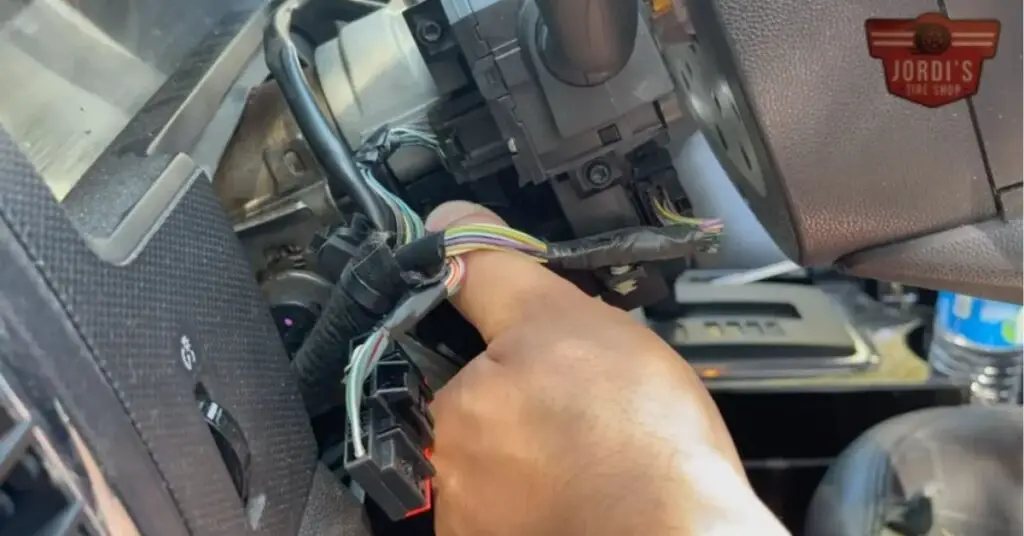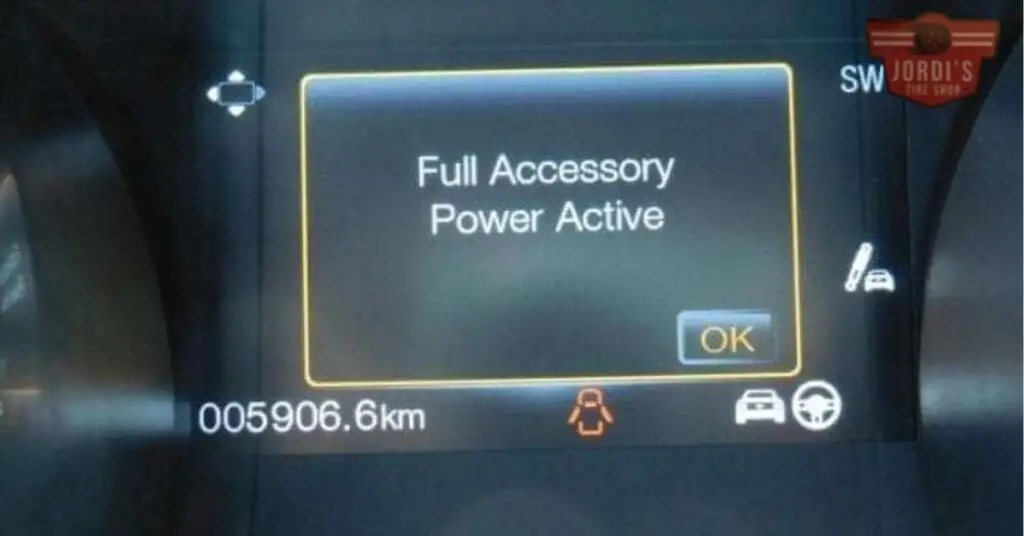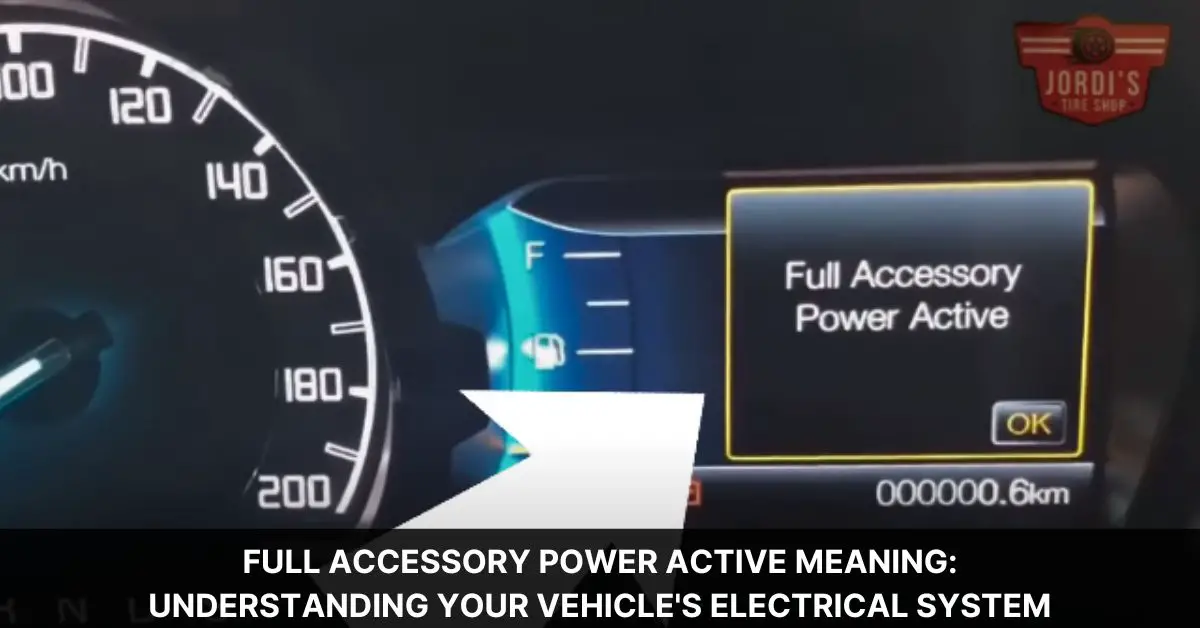Ever found yourself sitting in your car, key in the ignition, wondering what all those dashboard messages really mean? One message that often pops up is “full accessory power active,” a phrase that might seem cryptic at first glance. But don’t worry, we’re here to shed some light on it.
This term is all about the functionality of your vehicle’s electrical accessories when the engine isn’t running. It’s a feature that ensures you can still enjoy the radio, charge your phone, or use the navigation system without having the engine turned on. Understanding what it means can make your waiting time in the car more comfortable and convenient.
So, let’s dive into the world of automotive features together and uncover the mysteries behind “full accessory power active.” We promise to keep it simple and enlightening, ensuring you walk away with knowledge that makes your car feel a bit more like home.
Understanding Full Accessory Power Active Meaning

Expanding on the dashboard message “full accessory power active,” let’s delve deeper into its significance and operation. This feature plays a pivotal role in enhancing the comfort and convenience of your vehicle’s cabin, especially during those moments when you’re waiting inside the car but don’t want or need to run the engine.
When you see this message, it indicates that the vehicle’s electrical system is in a state that permits all or most of the electrical accessories to be used. This includes systems like your car’s infotainment center, lighting, power seats, windows, and even your HVAC system in some cases. Essentially, it turns your car into a powered mobile lounge without the additional fuel consumption or emissions associated with an idling engine.
There are a couple of things you need to know about managing this feature:
- Activation: Typically, this mode is activated by pressing the start button without pressing the brake pedal, or by turning the key to the accessory position in vehicles with a traditional key ignition.
- Battery Life: It’s important to monitor the duration of use in this mode, as prolonged use can drain the vehicle’s battery. Most modern vehicles are equipped with systems to warn the driver when the battery reaches a low state, reducing the risk of a dead battery.
Remember, utilizing the full accessory power active mode can make your wait time or any period spent in the vehicle with the engine off not just bearable but also quite enjoyable. Whether you’re listening to your favorite tunes, charging your gadgets, or simply enjoying the comfort of your car’s interior lights and features, this function ensures you can do so without having to run the engine. However, always be mindful of your battery’s charge level to avoid any inconvenient surprises.
The Importance of Full Accessory Power Active

Understanding the significance of the “full accessory power active” feature in our vehicles brings several advantages, primarily centered around convenience, energy efficiency, and vehicle longevity. When we activate this mode, our car allows us to use electronic features without running the engine, presenting a variety of benefits.
First, the convenience factor cannot be overstated. This mode lets us use the infotainment system, listen to music, charge our devices, or operate the power windows and seats, all while keeping the engine off. It’s particularly handy during short stops or while waiting for someone, enhancing our overall experience without sacrificing comfort.
Energy efficiency plays a crucial role in the importance of this feature. By utilizing the full accessory power active mode, we minimize fuel consumption since we’re not idling the engine just to use the electronics. This not only saves fuel but also reduces emissions, contributing to a healthier environment. In cities where idling laws are strict, this feature helps us comply with regulations effortlessly.
Vehicle longevity is another critical aspect. Idling can put unnecessary wear on our car’s engine over time. By using electronic features without keeping the engine running, we reduce engine wear, contributing to a longer life span for our vehicle. This results in lower maintenance costs and a better resale value in the long run.
Lastly, monitoring battery life becomes crucial with the activation of this mode. While it offers various comforts, ensuring our battery doesn’t drain completely is essential. Modern cars often include features that alert us before the battery reaches critically low levels, allowing us to manage our usage effectively and prevent being stranded with a dead battery.
By appreciating the importance of the full accessory power active mode, we make the most of our vehicle’s capabilities, ensuring comfort, efficiency, and longevity without compromising on convenience or environmental responsibility.
How Full Accessory Power Active Works
Building on the benefits of the “full accessory power active” mode, let’s dive into how this feature operates in modern vehicles. Essentially, it’s a smart mechanism that vehicles use to enhance user experience without compromising the vehicle’s battery life or engine efficiency.
When a driver activates the full accessory power mode, the vehicle’s electrical system disengages from the engine’s operations. This separation means that the vehicle can power infotainment systems, interior and exterior lighting, and the HVAC system without the engine running. It’s a clever way to save fuel and reduce emissions by not idling the engine unnecessarily.
The system operates through the vehicle’s onboard computer, which monitors the battery’s charge level. If the battery’s charge drops below a certain threshold, the system automatically shuts off, preserving enough charge to start the engine later. This ensures that the vehicle’s battery doesn’t drain completely, avoiding potential inconvenience and maintenance issues.
Furthermore, most vehicles equipped with this feature include settings that allow drivers to customize how and when the full accessory power mode activates. For example, drivers can set it to turn off automatically after a certain period or when the battery level reaches a specific point. This customization maximizes both the convenience and the efficiency of using the vehicle’s electrical features without running the engine.
The full accessory power active mode represents a thoughtful integration of technology designed to offer convenience while protecting the environment and the vehicle itself. It showcases how automotive manufacturers are innovating to meet the needs of modern drivers, providing comfort and sustainability in one package.
Comparing Vehicles With and Without Full Accessory Power Active

Exploring the difference between vehicles equipped with and those lacking the “full accessory power active” feature illuminates the stark contrasts in comfort, efficiency, and sustainability. Vehicles boasting this capability provide a level of convenience and energy conservation not found in their counterparts.
For starters, vehicles with this feature allow users to enjoy the infotainment system, climate control, and lighting without the engine running. This is a boon for waiting times in parking lots or during short breaks on long trips, ensuring that comfort and entertainment do not come at the cost of fuel consumption or unnecessary emissions. Moreover, the smart management system ensures battery health is never compromised, automatically shutting off the feature if the battery level gets too low.
On the other hand, vehicles without the “full accessory power active” mode demand the engine be running for the use of such electrical systems. This not only increases fuel consumption but also contributes to wear and tear on the engine, leading to potentially shorter vehicle life spans. Additionally, the constant need to idle the engine for power detracts from energy efficiency and increases the vehicle’s carbon footprint—an important consideration for environmentally conscious drivers.
Safety is another aspect where these vehicles diverge. With the feature enabled, drivers can control settings to ensure that essential functions like headlights and windshield wipers remain operational, enhancing safety in various conditions. In contrast, without this mode, reliance on manual management of these systems can lead to distractions or oversight, impacting safety.
Lastly, the resale value of vehicles with “full accessory power active” may be higher, given their advanced technology and convenience features. Such cars are often seen as more modern and desirable, an important factor for owners who consider future sale or trade-in.
The comparison reveals significant benefits in convenience, efficiency, sustainability, and safety for vehicles equipped with the “full accessory power active” feature, making it a highly desirable option in modern automotive design.
Troubleshooting Common Issues

When encountering problems with the “full accessory power active” mode in vehicles, we often find that these challenges can be straightforward to address. Let’s explore common issues and their solutions.
Battery Drains Quickly
Encountering a fast-draining battery can be alarming. First, check for any active electrical accessories that might be consuming power unnecessarily, such as lights or the entertainment system. Additionally, ensuring the car’s battery is in good condition and not nearing the end of its lifespan is crucial. Sometimes, it may simply be time to replace the battery to maintain optimal performance.
Feature Doesn’t Activate
If the “full accessory power active” feature won’t activate, the immediate step is to ensure the vehicle is in the correct mode. In some cars, this feature requires the ignition to be in a specific position, usually one notch before the engine starts. If the mode still doesn’t engage, we recommend checking the vehicle’s manual for any specific activation procedures or troubleshooting tips. It’s also worth examining the fuse associated with this feature, as a blown fuse could prevent it from working.
Electrical Accessories Not Working
When certain electrical accessories fail to work under “full accessory power active” mode, it’s often due to individual accessory issues rather than a failure of the entire system. We suggest checking each problematic accessory for any faults. For instance, if the audio system isn’t working, ensure it’s not muted or disabled in the settings. If these steps don’t resolve the issue, the accessory itself may require professional inspection.
System Management Errors
On rare occasions, the vehicle’s system management might display errors related to the “full accessory power active” mode. These errors could indicate a malfunction within the vehicle’s electronic control unit (ECU). In such cases, a professional diagnostic is advisable. Vehicle manufacturers often release software updates that fix these errors, so keeping the vehicle’s software up to date is beneficial.
Addressing these common issues can significantly enhance the experience of using vehicles equipped with the “full accessory power active” feature. Importantly, regular maintenance checks and prompt attention to any signs of trouble can prevent most of these problems from escalating, ensuring the vehicle remains efficient, convenient, and comfortable for all users.
Conclusion
We’ve walked through the ins and outs of the “full accessory power active” mode and its impact on our driving experience. It’s clear that this feature not only offers us a layer of convenience but also aligns with the eco-friendly practices many of us strive for. While there might be a few bumps along the road like battery drainage or system errors it’s nothing that can’t be managed with a bit of know-how and regular check-ups. Let’s embrace the benefits while staying mindful of our vehicle’s health. After all it’s about making our rides smoother and our planet a bit greener.
Related Posts:
- Exhaust Fluid System Fault: Causes, Symptoms, and Solutions
- Ford F150 Transmission Identification Codes: A Comprehensive Guide
- Ford Outside Temperature Sensor Reset: A Quick Guide
- Full Accessory Power Active Meaning: Understanding Your Vehicle’s Electrical System
- How to Bypass Ford Speed Limiter: Tips and Tricks
- What Year Ford Fusion Parts are Interchangeable: A Quick Guide

